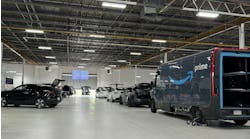Bubba Guerra wanted to provide a reasonable explanation; he wanted to be able to tell the customer something—anything—that would’ve regained her trust in the shop’s competency.
There just wasn’t anything he could say.
“It was a simple, three-day bumper job, and she’s calling after a week or so wondering where her car is,” he says. “I go back to the shop and it’s just sitting there, waiting in line at the paint booth behind all these massive jobs we’re working on.
“What can you really say? Sorry we’re slow?”
This was in late 2007, a year after Guerra came on board as the general manager of Yokem Auto Body and three years after the dealer-owned repair shop opened a sparkling, new, 30,000-square-foot facility in Shreveport, La.
The shop had the latest tooling, the top-of-the-line equipment and the training needed to work on any vehicle that came through its doors, not just the Toyotas its dealership sold.
Yet, its operations couldn’t support its volume. Work bottle-necked at every transition in the repair process. Ten-day jobs turned into 14-day jobs; two-day jobs turned into five-, six- and seven-day jobs—and angry phone calls from customers.
“It was an operational issue,” Guerra says. “With the volume we had, and the mix of work, we had to find a way to get shorter jobs through quickly without interrupting those big jobs.”
Guerra had an idea, one that would help to eventually transform the shop into one of Toyota’s top dealer facilities in the country.
The Backstory
Guerra says Yokem isn’t your typical dealer shop, and a big part of that is because of its dealership’s guiding principles of customer service. Yokem Toyota has been recognized with the automaker’s highest honor, the President’s Award, 23 times through 2013. The award recognizes customer service and community involvement.
Strategic Account Manager
Axalta Coating SystemsNew (Faster) Mentality We have to get out of the old, bring-it-in-Monday, drop-it-off-Friday mindset with repairs. We need to look at the work mix, and schedule based on that. Every shop can do it, and every shop should be doing it. And there are two simple keys to doing it effectively: 1. Establish tiers. You need to make designations for light, medium and heavy jobs in your shop, and develop a workflow process for each. 2. Schedule appropriately. On the phone, you should establish which tier a vehicle falls into and slot it into the right time. A “fast lane” or “light” job has to come in in the morning and be started right away. Parts should be preordered, jammed, prepped or painted before hand. That way you can get a jump on the repair when it comes in.
The dealership’s ownership group opened the body shop in 2001, looking to extend its customer experience a step further.
“Our dealership stands behind the body shop in everything we do,” Guerra says. “A lot of dealers have shops but don’t put the effort into it. The principles here treat it like they would the service department or parts; they want us to be successful, and they give us the training and equipment to get us in that position.”
Guerra came on board after spending six years as an estimator with State Farm. His travels that took him in and out of the most successful shops in the Bayou helped Guerra bring a numbers-focused, systematic approach to operations.
Everything was predicated on taking care of customers, and the shop, which became certified in Toyota and Scion repair and was equipped and trained to work on an array of high-end vehicles, focused on quality of the repair.
The shop’s revenue grew in each of Guerra’s first two years at the helm.
The Problem
Key performance indicators were never diligently tracked in the shop’s early years, but coming on in 2006, Guerra focused on metrics in finding ways to improve the shop’s workflow.
While car count and sales grew, the shop approached capacity—or at least struggled to take on additional work, Guerra says.
Cycle time hovered around a dozen days per job; the shop’s emphasis on service at the front counter and quality of the finished product were enough to keep customers and insurance partners satisfied, but overall operations were hectic.
Being busy should be a goal for the shop, Guerra says, not an excuse for under-delivering for customers. Phone calls like the one mentioned previously were coming in too frequently, and Guerra knew the shop needed to make drastic changes.
The Solution — Phase I
The answer, in theory, was simple enough: If the shop could separate its hard-hit jobs from its light work, vehicles could move through the shop at a more suitable pace.
In 2008, Guerra worked with his team to do just that.
The shop set a clear designation for “fast-lane jobs,” capping those at repairs that require six hours of bodywork or less and need no more than four panels painted. The jobs would be separated at the time of the first walk-through with a customer. (If jobs are later found to be more intense than expected, they are shifted to the hard-hit category.)
All jobs would share an estimator, teardown, prep and detail space in the shop. But Guerra designated three working bays to fast-lane work, and one spray booth.
He assigned one body tech, one body “helper” and one painter to the “fast-lane” team, and work flowed that way for four years, as the team refined the process.
Cycle time was cut down; it dropped below double digits for the entire shop, and the fast-lane team processed just more than three vehicles per day.
Yet, Guerra says, work was still bottlenecking during the prep and detail steps of the process.
In 2012, the dealership’s willingness to invest in the shop took the business to a whole new level.
The Solution — Phase II
The shop’s fast-lane production started to become an entirely new profit center for the business, creating high-volume workloads that helped the shop position itself for even further growth.
Ownership was looking at an expansion of the facility, one that could help improve its profit centers. Guerra and his team had a clear idea of the shop’s best opportunity: a completely separated fast-lane segment.
The addition to the building would give Guerra an opportunity to design a highly efficient fast-lane track from the ground up. He worked with his techs, estimators and customer service staff to formulate a thorough plan.
The goal was to optimize both the fast-lane work, while also streamlining aspects of the shop’s soon-to-be-larger hard-hit space (it gained the square footage previously occupied by quick jobs).
With the plan finalized and approved, construction began on a 5,000-square-foot addition in 2012: 3,500 square feet to be dedicated to the fast lane; the rest to be an expanded detail department.
THE SET UPEvery aspect of the new fast-lane shop was scrutinized and planned thoroughly. In the end, this is what Yokem ended up with:
1) LAYOUT:
Five working body bays; a double-sized prep station; one paint booth; one mixing room.
The stations are laid out in a straight-forward, circular flow, so that the team can pull vehicles from station to station. (See graphic for details).
“We wanted things to be as simple as possible with a clear flow,” Guerra says. “With the way it’s set up, a vehicle just moves a few feet from one station to the next.”
2) TEAM:
One experienced body tech, one “helper” body tech, one painter and another overall “helper.” The staff works in a team production system, focusing on moving vehicles through together as unit, rather than completing full repairs on vehicles themselves.
The “helper” positions also serve as pseudo-apprenticeships, Guerra says, as those are filled by less experienced technicians who can learn from the lead tech on simpler, quick jobs.
“The biggest thing is having the right people who want that team environment; not all techs do,” Guerra says, noting that the he filled the entire team with in-house staff, shifting people to different positions rather than bringing in new hires.
3) PROCESS:
The fast-lane workflow follows four steps:
A) Initial Estimate. Estimating is still performed by the staff at the shop’s central front counter. This is done through the initial meeting with the customer. Fast-lane work is often clearly identifiable, and the shop still sticks to its original designation requirements: no more than six hours of bodywork, a maximum of four panels being painted.
B) Appointment/Parts Ordering. Every fast-lane job is done by appointment. Once the appointment is made, parts are ordered so that they are ready upon the vehicles arrival.
C) Repair/Paint/Detail. Upon arrival, the vehicle then goes through the repair process highlighted in the graphic. Work is tracked through a dry-erase board in the shop, updated daily by the front office team.
D) Vehicle Delivery. The front office staff then handles delivery of the vehicle.
The Takeaway
The fast-lane shop has been open for more than two years now, and the efficiencies shopwide are clear cut, Guerra says. On a “typical day,” the fast-lane team completes at least six jobs, nearly double what it was doing when it was part of the original shop floor. Cycle time is less than two days.
In the main facility, the shop’s cycle time on hard-hit work is now below 10 days, nearly a full day below the business’s overall cycle time on all work (including fast-lane jobs) before the new building was added.
The facility upgrade, including all equipment, cost $300,000. But the return will be quick, Guerra says, as it was essentially an investment in “a second shop,” that is already producing at a profitable level.
“Obviously not everyone has the backing to add on like that, but it’s about finding efficiencies and finding those problem areas that you can improve,” Guerra says. “For us, the biggest difference wasn’t about being able to have that space; it was having the right people who had the right attitude to make these significant changes in the shop work.
“Everyone worked together closely on this, and everyone was invested in the changes we made. You can’t have success and improvement without everyone having that team-first mentality.”




